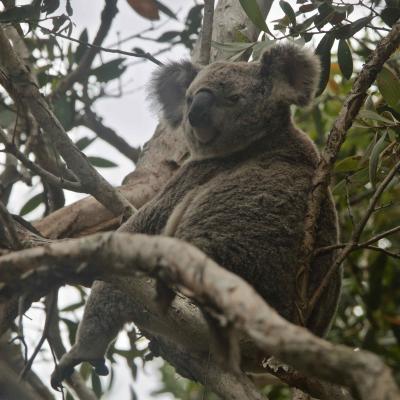DNA and GIS research led by USC Australia has identified two unique and genetically distinct koala populations in the Noosa Shire, which could be one key to securing their future.
The groundbreaking research led by Dr Celine Frere and the USC Detection Dogs for Conservation team used state-of-the-art modelling to determine genetic connectivity between koalas living in the Noosa Biosphere Reserve.
Researchers used geographic information system (GIS) analysis and genetic data from koala scat (poo) samples to determine whether existing habitat corridors are actually connecting koalas.
Overall, vegetation and koala genetic connectivity was high across the Noosa Shire. However, researchers found that Noosa Heads koalas are impeded in their connectivity to koalas in other parts of the region by lack of appropriate vegetation connectivity. This has resulted in two unique and genetically distinct koala populations in the Noosa Biosphere.
One koala population was identified in the peri-urban area of Noosa Heads and Tewantin; the other among three clusters across the Yural and Ringtail Forest Reserves, Woondum National Park, and West Cooroy and Tuchekoi.
To help secure the long-term survival of wild koalas in the Noosa region, Dr Celine Frere says we first need to understand landscape and population connectivity.
“We have now gained a much clearer understanding of the fine-scale distribution of koalas throughout the Noosa Shire and, importantly, how they are connected both through the landscape and genetically. This information was critical to development of targeted management actions,” Dr Frere said.
Frere’s report identifies priority locations where vegetation and habitat connectivity should be improved to support mixing of koala populations.
This latest research builds on previous work co-funded by the Noosa Biosphere Reserve Foundation (NBRF) and WWF Australia, using specially trained koala scat detection dogs to map koalas across the Noosa region.
NBRF chair Rex Halverson said Dr Frere’s research was crucial to informing more effective actions that can be taken to protect and restore wild koala populations in the Noosa Biosphere.
“We now have a deeper understanding of our local koalas and their movements and this new knowledge will help develop solutions that will make a difference,” he said.
A lack of habitat connectivity is one of the major issues affecting the future survival of koalas in the Noosa region – exacerbating common threats such as car strikes, dog attacks, disease and low genetic diversity caused by inbreeding.
Across South East Queensland, koalas have suffered population declines of up to 80 percent and are now considered vulnerable to extinction without proactive measures being undertaken.
The research project was a collaboration between USC Australia, Noosa Parks Association, WWF Australia and the Noosa Biosphere Reserve Foundation. More information is available at www.noosabiosphere.org.au.







